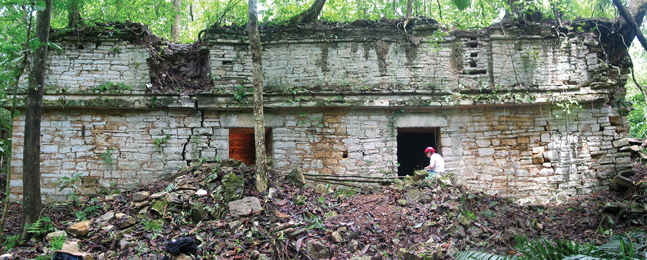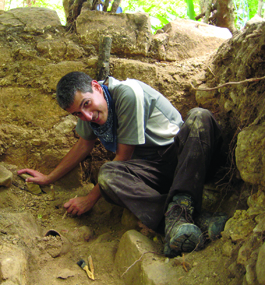Civilization and Its Discontents

Photo by A. Heginbotham. Photos courtesy Sierra del Lacandon Regional Archaeological Project
by RICHARD ANTHONY
To clear up a few points for the Indiana Jones aficionados out there, Brandeis archaeologist Charles Golden shuns fedoras, doesn’t know how it feels to be hurled into a pit full of vipers, and has never evaded ravenous piranhas by clinging to the struts of a seaplane making an emergency takeoff.
But if not a match for Hollywood’s famed scholar-swashbuckler in that sense, Golden does have tales to tell. His studies of the Maya take him to swatches of dense jungle in Guatemala and Mexico, among other locales. And that can put him in harm’s way.
“I’ve had two bouts of malaria,” says Golden, an associate professor of anthropology.
Following his first infection he was in denial, going on a vacation instead of getting treated. “I was at a London museum,” he recalls, “and when the letters in the signage started looking as if they were dripping down the walls, I said, ‘OK, this is bad; I’m going to the hospital.’”
Golden has also sustained a scorpion’s sting, which he likens to the “worst bee sting imaginable.” And he’s had run-ins with armed locals, often poachers or illegal woodcutters upset by his team’s presence.
Such encounters have not led to gunplay, partly because he and his colleagues tend to choose ex-guerrillas as guides. “They’re well prepared to deal with complex situations,” Golden notes dryly. On the other hand, a group of locals a few kilometers away from his team’s camp once unleashed a fusillade of shots into the air as a warning to the intruders.
Understandably, Golden tries to minimize risks. In fact, that is why one of his signal contributions to Mayan scholarship occurred six years later than it might have.

Photo by A. Scherer
page 2 of 2
Walls and Insights
In 1998, Golden, then a Ph.D. student at the University of Pennsylvania, was traversing a border area between two Mayan kingdoms. The kingdoms’ capitals, Piedras Negras (on the Guatemalan side of a major river, the Usumacinta), and Yaxchilan (on the Mexican side) were well studied. But his interest lay in some sites largely unknown except to locals.
As his party hacked its way through the jungle, Golden had a kind of wake-up call. “When you’re walking along, and you step up and right away step down, you think, “There’s something under there,’” he says.
That something was a low, deteriorated limestone wall. But while intrigued by the find, Golden was also eager to avoid one of the deadly legacies of Guatemala’s 36-year civil war. “There were strong rumors of land mines in the area,” he explains. So he and his team moved on.
Six years later, with a different group, Golden stumbled on another such wall. This structure, too, was near the Usumacinta, which forms part of the border between Guatemala and Mexico. And the setting was safe enough that the team could study the wall. In the process, the explorers began acquiring new insights into the Maya, possibly including the vexing issue of why the civilization collapsed between about 800 and 925 C.E.
Unlike, say, the ancient Greeks, the Maya have an air of mystery about them. That’s partly because the written record is sparse. “The Spanish burned thousands of Mayan books,” notes Golden.
But the dearth of writings is just one issue. The Maya also had beliefs and practices foreign to our own: conducting human sacrifices, for example, and possessing a worldview that holds houses, mountains and other objects to be alive. A sense of otherworldliness, moreover, suffuses many iconic Mayan scenes, like that of a pyramidal temple rising above the canopy of a dark, sprawling jungle.
Mysterious or not, scholars have made much headway in understanding the Maya. But the progress to date has been somewhat selective, emphasizing the major Mayan cities. So Golden and collaborator Andrew Scherer, a Brown University archaeologist, decided to explore in between sites: towns, small settlements, military emplacements.
Ceding Royal Powers
The explorers are intrigued by a specific theory about the civilization’s collapse, that leaders in outlying areas of some kingdoms were able to distance themselves from the kings who were their putative rulers, triggering a centrifugal process that in time led to the downfall of those realms at the end of the so-called Classic period, around 800 C.E.
To vet this idea, Golden and Scherer have focused on the borders between kingdoms. In the process, they’ve found indirect support for the idea that turbulence among the elite doomed some kingdoms.
Take those walls. They turned out to be located in key passes between Piedras Negras and Yaxchilan. And they reflected an approach to military security rarely encountered before in a Mayan context.
“The walls, we think, were about the Yaxchilan kings staking out territory,” says Scherer. “But to do so, they may have ceded authority to their warlords, who theoretically reported to them. Those warlords could then have easily started pursuing their own interests.”
The researchers recently launched a new study, seeking further insights into the Classic period’s demise. And, as with all their studies, the archaeologists are pursuing this one with an urgency that reflects their fears for the survival of Mayan sites of many types.
The threat stems from looting and from the clearing of many of the jungle landscapes that have provided a natural shield for Mayan sites, among other activities. Then there is the especially worrisome issue of hydroelectric dams.
The damming of the Usumacinta, long discussed, is on hold. But, notes Golden, “My sense is that the plan is dormant like a volcano. Any government promoting development has to think about how to increase supplies of electricity.”
Golden says many facets of his work, including, at times, bushwhacking through dense jungle with machete in hand and a 50-pound pack on his back, are rewarding. “It takes you to the limits of what you think you’re capable of, and a little beyond,” he says. But the reality is that much of the work is a tough slog.
There’s the matter of negotiating with locals who do not want you around. There’s jumping through often-confusing bureaucratic hoops to get permits. And there’s the never-ending quest for funds.
“You can get exhausted,” says Golden. “There have been innumerable times when I would have loved to take a real break. But there’s also that sense that, if you do, something invaluable may be lost. And that’s what keeps you going.”
